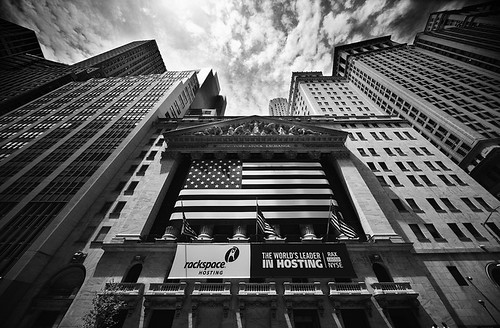Some comparison
Recently I got hold of some old lectures of Walter Schloss, a renowed value investor who was only noticed by Wall Street when Warren Buffett
who was only noticed by Wall Street when Warren Buffett mentioned his name in "The superinvestors of Graham and Doddsville". One of his letters talks about overvaluation in Blue-chip stocks sometime around May 1956. He talks about four companies namely, General Electric (GE 19.80 ↓-1.05%), Dow Chemical (DOW 33.83 ↓-0.85%), Minnesota Mining (3M (MMM 88.01 ↓-0.50%)) and Minneapolis Honeywell (HON 59.96 ↓-1.30%). Here is a snippet from the article:
mentioned his name in "The superinvestors of Graham and Doddsville". One of his letters talks about overvaluation in Blue-chip stocks sometime around May 1956. He talks about four companies namely, General Electric (GE 19.80 ↓-1.05%), Dow Chemical (DOW 33.83 ↓-0.85%), Minnesota Mining (3M (MMM 88.01 ↓-0.50%)) and Minneapolis Honeywell (HON 59.96 ↓-1.30%). Here is a snippet from the article:
How this can be compared with our current valuations? See some of my previous post on overvaluation in FMCG and Pharma here. I am repeating the table here with some additions:
Even companies like Bajaj Electrical, Hawkins (HWKN 37.77 ↑0.13%) cooker and TTK Prestige are trading at 60-70 times last 10 years earnings. Nestle, which nearly pays all its earnings as dividends , yields just 1.55% at the current price. Remember that the price-wise correction wasn't very severe in US. But over the next 24 years, i.e. till 1980, the index just managed to double from 500 to around 1000, a return of less then 3% compounded annually. Investor would have got dividends though to satisfy himself. May God Bless Indian Investor at this time.
, yields just 1.55% at the current price. Remember that the price-wise correction wasn't very severe in US. But over the next 24 years, i.e. till 1980, the index just managed to double from 500 to around 1000, a return of less then 3% compounded annually. Investor would have got dividends though to satisfy himself. May God Bless Indian Investor at this time.
Dow chemical, based on its current price, is selling at 49 times is earnings for the past 10 years. Similarly, Minnesota Mining is presently selling at 61 times its last 10 years earnings, 51 times its last 5 years earnings and 32 times its 1955 earnings.
One of the four companies (General Electric) is distributing nearly all its current earnings and still only yields 3.1%.
How this can be compared with our current valuations? See some of my previous post on overvaluation in FMCG and Pharma here. I am repeating the table here with some additions:
| Share | Market Cap (INR Cr) | TTM P/E | P/E of 10 Year Average EPS |
|---|---|---|---|
| 3M India | 3860 | 41.23 | 87.5 |
| ABB (19.97 ↓-1.14%) | 16525 | 58.4 | 61.8 |
| Asian Paints (500820 3188.45 ↑2.81%) | 26950 | 30.6 | 96.1 |
| BHEL | 116900 | 27 | 67.8 |
| Bosch (500530 7600.10 ↓-1.33%) | 18870 | 25.37 | 51.5 |
| Colgate (CL 95.74 ↓-0.32%) | 11275 | 24.8 | 66.5 |
| Crompton Greaves (EQCROMPGREAV 133.95 ↓-2.62%) | 19500 | 22.7 | 78.2 |
| Cummins (CMI 116.85 ↓-0.96%) India | 14450 | 32.8 | 65.9 |
| Dabur | 18509 | 35.69 | 82.25 |
| Exide (XIDE 3.03 ↓-0.98%) | 12760 | 25.85 | 87 |
| Godrej Consumer Products | 9860 | 29 | 83 |
| HDFC Bank (EQHDFCBANK 510.10 ↓-0.65%) | 100000 | 34 | 91.9 |
| Infosys (INFY 55.55 ↓-0.64%) | 159650 | 25.95 | 55.7 |
| Marico (531642 169.30 ↑0.50%) | 7550 | 32.6 | 70 |
| Nestle (NSRGY 62.00 ↓-0.56%) | 30630 | 43.7 | 94.4 |
| Titan | 13400 | 46.75 | 164.35 |
Even companies like Bajaj Electrical, Hawkins (HWKN 37.77 ↑0.13%) cooker and TTK Prestige are trading at 60-70 times last 10 years earnings. Nestle, which nearly pays all its earnings as dividends
It appears to be a financial axiom that whenever there is money to invest, it is invested; and if the owner cannot find a good security yielding a fair return, he will invariably buy a poor one. But a prudent and intelligent investor should be able to avoid this temptation. - Benjamin Graham

 sectors as defensive. But if we look at the returns generated by these companies over long term, they are many a times much better than the returns generated from index. Today, I will describe two good companies from FMCG sector which have shown the same kind of characteristics over the last 10 years. The first is Nestle and the other one is Glaxosmithkline Consumer Healthcare. If you look at the returns generated by these companies over the last ten years, they can be summarized as shown in the following table:
sectors as defensive. But if we look at the returns generated by these companies over long term, they are many a times much better than the returns generated from index. Today, I will describe two good companies from FMCG sector which have shown the same kind of characteristics over the last 10 years. The first is Nestle and the other one is Glaxosmithkline Consumer Healthcare. If you look at the returns generated by these companies over the last ten years, they can be summarized as shown in the following table:







